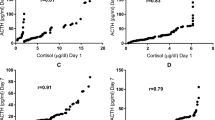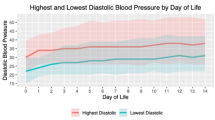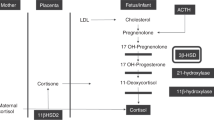Abstract
Objectives:
Temporal relation between adrenal insufficiency and hypotension is poorly understood. We examined the association between basal and post-stimulation cortisol and death or vasopressor refractory hypotension in preterm neonates.
Study Design:
Prospective cohort study in ≤30 weeks’ and/or <1,250 g weight. Primary outcome-composite of death or vasopressor refractory hypotension by day 14 of life. Plasma cortisol levels were measured at 24–36 h (T1), 72–84 h (T2) and 10 days (T3), and post-stimulation cortisol at T1 and later at T2 and T3 if the adrenal response was inadequate earlier.
Results:
Basal cortisol (µg/dl) at 24–36 h was significantly higher in the outcome group (37.2 ± 21.1 vs. 22.04 ± 14.6; mean difference (MD) (95% confidence interval (CI)): −15.1 (−23.6, −6.6); p = 0.005). High basal cortisol at 24–36 h (odds ratio (OR) (95% CI): 1.044 (1.009, 1.079); p = 0.01) and need for ventilation (OR (95% CI): 9.7 (1.2, 81.2); p = 0.04) independently increased the risk of death or vasopressor refractory hypotension.
Conclusion:
Preterm neonates who died or developed vasopressor refractory hypotension by day 14 had significantly elevated basal cortisol at 24–36 h of life.
This is a preview of subscription content, access via your institution
Access options
Subscribe to this journal
Receive 12 print issues and online access
$259.00 per year
only $21.58 per issue
Buy this article
- Purchase on Springer Link
- Instant access to full article PDF
Prices may be subject to local taxes which are calculated during checkout



Similar content being viewed by others
References
Drouin E, Gournay V, Calamel J, Mouzard A, Roze JC. Assessment of spontaneous baroreflex sensitivity in neonates. Arch Dis Child Fetal Neonatal Ed. 1997;76:F108–12.
Mesiano S, Jaffe RB. Developmental and functional biology of the primate fetal adrenal cortex. Endocr Rev. 1997;18:378–403.
Miall-Allen VM, de Vries LS, Whitelaw AG. Mean arterial blood pressure and neonatal cerebral lesions. Arch Dis Child. 1987;62:1068–9.
Wu TW, Azhibekov T, Seri I. Transitional hemodynamics in preterm neonates: clinical relevance. Pediatr Neonatol. 2016;57:7–18.
Bourchier D, Weston PJ. Randomised trial of dopamine compared with hydrocortisone for the treatment of hypotensive very low birthweight infants. Arch Dis Child Fetal Neonatal Ed. 1997;76:F174–8.
Heckmann M, Wudy SA, Haack D, Pohlandt F. Serum cortisol concentrations in ill preterm infants less than 30 weeks gestational age. Acta Paediatr. 2000;89:1098–103.
Helbock HJ, Insoft RM, Conte FA. Glucocorticoid-responsive hypotension in extremely low birth weight newborns. Pediatrics. 1993;92:715–7.
Ng PC, Lee CH, Bnur FL, Chan IH, Lee AW, Wong E, et al. A double-blind, randomized, controlled study of a “stress dose” of hydrocortisone for rescue treatment of refractory hypotension in preterm infants. Pediatrics. 2006;117:367–75.
Tantivit P, Subramanian N, Garg M, Ramanathan R, deLemos RA. Low serum cortisol in term newborns with refractory hypotension. J Perinatol. 1999;19:352–7.
Thomas S, Murphy JF, Dyas J, Ryalls M, Hughes IA. Response to ACTH in the newborn. Arch Dis Child. 1986;61:57–60.
Efird MM, Heerens AT, Gordon PV, Bose CL, Young DA. A randomized-controlled trial of prophylactic hydrocortisone supplementation for the prevention of hypotension in extremely low birth weight infants. J Perinatol. 2005;25:119–24.
Hochwald O, Pelligra G, Osiovich H. Adding hydrocortisone as 1st line of inotropic treatment for hypotension in very low birth weight infants: authors’ reply. Indian J Pediatr. 2014;81:988.
Baud O, Maury L, Lebail F, Ramful D, El Moussawi F, Nicaise C, et al. Effect of early low-dose hydrocortisone on survival without bronchopulmonary dysplasia in extremely preterm infants (PREMILOC): a double-blind, placebo-controlled, multicentre, randomised trial. Lancet. 2016;387:1827–36.
Watterberg KL, Scott SM. Evidence of early adrenal insufficiency in babies who develop bronchopulmonary dysplasia. Pediatrics. 1995;95:120–5.
Hochwald O, Holsti L, Osiovich H. The use of an early ACTH test to identify hypoadrenalism-related hypotension in low birth weight infants. J Perinatol. 2012;32:412–7.
Aucott SW, Watterberg KL, Shaffer ML, Donohue PK, group Ps. Early cortisol values and long-term outcomes in extremely low birth weight infants. J Perinatol. 2010;30:484–8.
Alkalay AL, Klein AH, Nagel RA, Pomerance JJ. Evaluation of hypothalamic-pituitary-adrenal axis in premature infants treated with dexamethasone. Am J Perinatol. 1996;13:473–7.
Grinspoon SK, Biller BM. Clinical review 62: laboratory assessment of adrenal insufficiency. J Clin Endocrinol Metab. 1994;79:923–31.
Korte C, Styne D, Merritt TA, Mayes D, Wertz A, Helbock HJ. Adrenocortical function in the very low birth weight infant: improved testing sensitivity and association with neonatal outcome. J Pediatr. 1996;128:257–63.
Vance ML. Hypopituitarism. N Engl J Med. 1994;330:1651–62.
Zubrow AB, Hulman S, Kushner H, Falkner B. Determinants of blood pressure in infants admitted to neonatal intensive care units: a prospective multicenter study. Philadelphia Neonatal Blood Pressure Study Group. J Perinatol. 1995;15:470–9.
Yoder B, Martin H, McCurnin DC, Coalson JJ. Impaired urinary cortisol excretion and early cardiopulmonary dysfunction in immature baboons. Pediatr Res. 2002;51:426–32.
Judd AM. Cytokine expression in the rat adrenal cortex. Horm Metab Res. 1998;30:404–10.
Andreis PG, Neri G, Belloni AS, Mazzocchi G, Kasprzak A, Nussdorfer GG. Interleukin-1 beta enhances corticosterone secretion by acting directly on the rat adrenal gland. Endocrinology. 1991;129:53–7.
Engström L, Rosén K, Angel A, Fyrberg A, Mackerlova L, Konsman JP, et al. Systemic immune challenge activates an intrinsically regulated local inflammatory circuit in the adrenal gland. Endocrinology. 2008;149:1436–50.
Ng PC. Is there a “normal” range of serum cortisol concentration for preterm infants? Pediatrics. 2008;122:873–5.
Heckmann M, Hartmann MF, Kampschulte B, Gack H, Bodeker RH, Gortner L, et al. Assessing cortisol production in preterm infants: do not dispose of the nappies. Pediatr Res. 2005;57:412–8.
Martins PG, Procianoy RS. Cortisol and 17-alpha-hydroxy-progesterone levels in infants with refractory hypotension born at 30 weeks of gestation or less. Braz J Med Biol Res. 2007;40:577–82.
Ng PC, Lee CH, Lam CW, Ma KC, Chan IH, Wong E, et al. Early pituitary-adrenal response and respiratory outcomes in preterm infants. Arch Dis Child Fetal Neonatal Ed. 2004;89:F127–30.
Broide J, Soferman R, Kivity S, Golander A, Dickstein G, Spirer Z, et al. Low-dose adrenocorticotropin test reveals impaired adrenal function in patients taking inhaled corticosteroids. J Clin Endocrinol Metab. 1995;80:1243–6.
Watterberg K, Shaffer ML, Garland JS, Thilo EH, Mammel MC, Couser RJ, et al. Effect of dose on response to adrenocorticotrophin in extremely low birth weight infants. J Clin Endocrinol Metab. 2005;90:6380–85.
Ng PC, Lam CWK, Lee CH, Ma KC, Fok TF, Chan IHS, et al. Reference ranges and factors affecting the human corticotrophin-releasing hormone test in preterm, ery low birth weight infants. J Clin Endocrinol Metab. 2002;87:4621–28.
Guillet R, Saffran M, Michaelson SM. Pituitary–adrenal response in neonatal rats. Endocrinology. 1980;106:991–4.
Walker CD, Perrin M, Vale W, Rivier C. Ontogeny of the stress response in the rat: role of the pituitary and the hypothalamus. Endocrinology. 1986;118:1445–51.
Acknowledgements
Funding
A special research grant of 100,000 INR was awarded by the Research Grant Cell of the Postgraduate Institute of Medical Education and Research, Chandigarh, India (internal funding) and a thesis financial grant of 25,000 INR by the Indian Council of Medical Research, New Delhi. These funds were utilized for the purchase of ECLIA kits for analysis of plasma cortisol and ACTH. However, both the organizations did not have any role in the design and conduct of the study; collection, management, analysis, and interpretation of the data; preparation, review, or approval of the manuscript; and decision to submit the manuscript for publication.
Author information
Authors and Affiliations
Corresponding author
Ethics declarations
Conflict of interest
The authors declare that they have no conflict of interest.
Rights and permissions
About this article
Cite this article
Rameshbabu, M., Sundaram, V., Sachdeva, N. et al. Association between plasma cortisol and death or vasopressor refractory hypotension in preterm neonates: a prospective, cohort study. J Perinatol 38, 672–680 (2018). https://doi.org/10.1038/s41372-018-0059-1
Received:
Revised:
Accepted:
Published:
Issue Date:
DOI: https://doi.org/10.1038/s41372-018-0059-1



